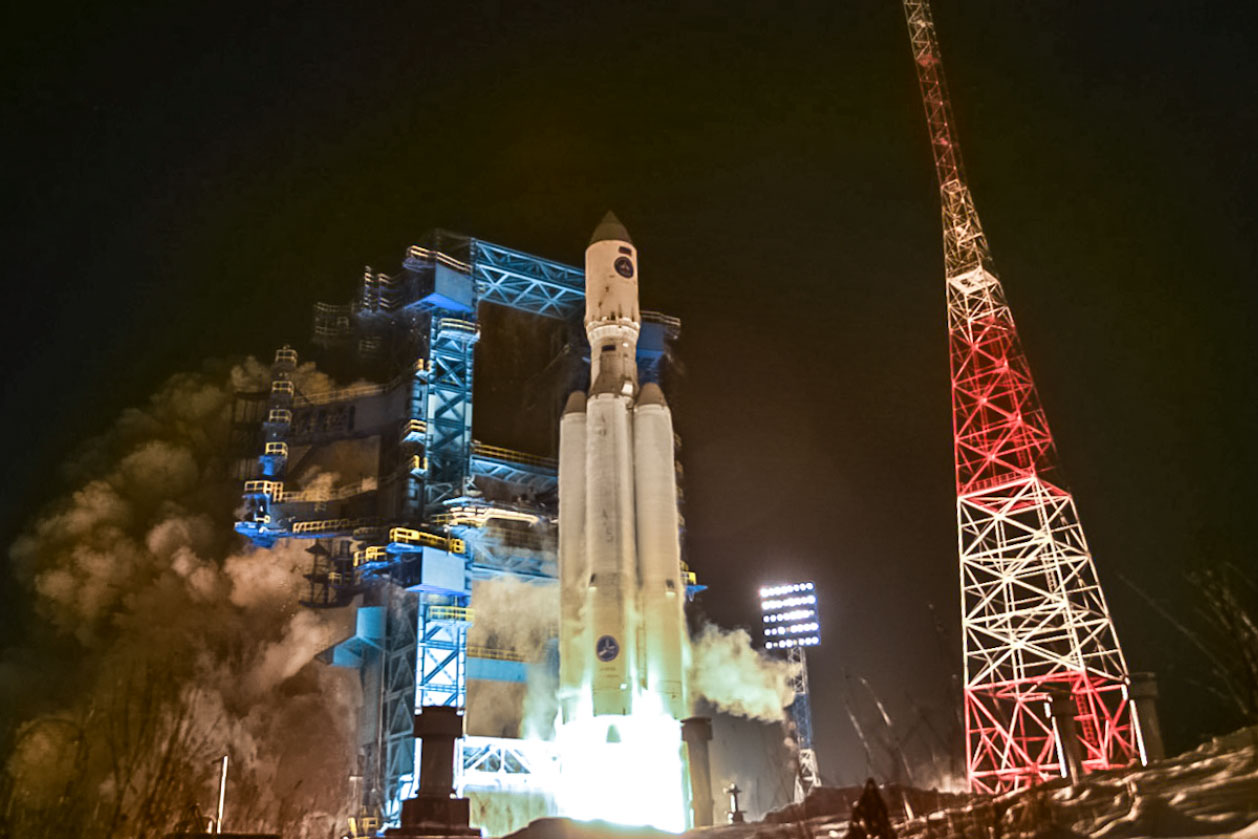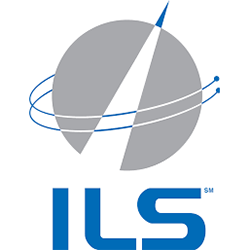Angara

Night test launch of the Angara-A5 heavy lift launch vehicle from the Plesetsk cosmodrome, December 14, 2020.
International Launch Services
1875 Explorer Street, Suite 700
Reston, VA 20190
+! 571-633-7400
+1 571-633-7500 fax
Web site: www.ilslaunch.com
Test launch of the Angara 1.2 medium-lift launch vehicle from the Plesetsk cosmodrome, July 9, 2014.
Angara Vehicle Descriptions
General Description
National Origin
RussiaMain Organization
Summary
Flight Rate
Estimated Launch Price
No data available
Spaceports
Launch Operations—Plesetsk
Angara will launch from both the Plesetsk Cosmodrome in northern Russia and the Vostochny Cosmodrome in the Russian Far East. A primary purpose of the Angara program is to provide Russia with a medium-to heavy-lift capability from a spaceport on Russian soil. Currently the largest launch vehicle supported at Plesetsk is the medium-lift Soyuz.
Angara will use the launch complex that was started, but not completed, for the Zenit launch vehicle. Until the breakup of the Soviet Union, it was planned that Zenit would be launched from two pads at the new Launch Complex 35 in Plesetsk. Following the breakup, Russia decided not to invest in infrastructure for a launch vehicle that was primarily built by Ukraine. As a result, the Zenit pads were not completed. For the Angara program, Pad 1 at Launch Complex 35 will be completed with a modified design to support Angara instead of Zenit. Because Angara’s RD-191 engine is derived from the Zenit first-stage engine and Angara’s aft compartment is designed to be similar to Zenit, the smaller Angara configurations are largely compatible with the existing pad design. The larger Angara configurations need a modified launch mount for the strap-on boosters and cryogenic propellant storage and fueling facilities. Angara will be integrated and tested horizontally in the assembly facilities built for Zenit.
Angara is integrated, tested, and checked out horizontally in the Assembly and Test Building at Area 142. Spacecraft operations for small spacecraft are performed at the Rockot facilities at Area 32T about 10 km from the launch complex. A larger Unified Technical Complex is being built at Area 171 that will allow processing of both large and small spacecraft as well as their upper stages. Spacecraft processing is conducted in parallel with launch vehicle processing. The spacecraft and the Breeze stage are fueled separately, then mated and enclosed in the payload fairing. The integrated assembly is then transported to the Assembly and Test Building for integration onto the launch vehicle in the horizontal position. When ready, the launch vehicle is transported to the launch pad horizontally and erected into the vertical position. Umbilical connections and fueling lines in the launch pad automatically connect to mating adapters on the bottom of the first stage. The second stage and KVRB umbilicals and feed lines are connected to a service tower.
Launch Operations—Vostochny
Under Roscosmos' tender announced in July 2012 and code-named Amur (after a great Siberian river), the Angara-5 rocket would be customized to fly from Vostochny, carrying a 20-ton new-generation PTK NP spacecraft. The first phase in the development of the Amur project would run until the end of May 2013, Roscosmos said.
In addition to its role in the piloted space program, the Angara's launch complex in Vostochny would complement or even replace the original Angara facility in Plesetsk for launches into the geostationary orbit. Thanks to a much better geographical location of Vostochny for launches to the equatorial orbit, Angara-5 could carry a larger payload when compared to the same vehicle based in Plesetsk. For missions to the geostationary orbit from Vostochny, Angara-5 could be also upgraded with the cryogenic KVTK upper stage when carrying its largest payloads and with the Block-DM stage for smaller satellites.
Given extremely remote location of the Vostochny launch site in the Russian Far East and limitations of region's rail lines for non-standard cargo, Roscosmos hoped to break with the tradition of shipping rocket stages to the launch site by train. Instead, the agency considered a possibility of taking advantage of Russia's An-124-100 Russian transport aircraft for the delivery of Angara's rocket stages. However, ultimately, rail transportation was chosen for the task.
TsENKI (Center for Operation of Space Ground-based Infrastructure, a subsidiary of Roscosmos State Corporation) has been constructing dedicated launch facilities at Vostochny despite budgetary shortcomings and construction delays. The arguments for choosing this location include the ability to use sparsely populated areas and bodies of water for the rocket launch routes; proximity to major transportation networks such as the Baikal–Amur Mainline, the Chita–Khabarovsk Highway; abundance of electricity production resources in the area; and the infrastructure supporting the former Svobodny Cosmodrome, on which the new spaceport will be based. The site's location in the Russian far eastern region allows for easier transport of materials to the site, and allows rockets to jettison their lower stages over the ocean. The decision to design a new cosmodrome was also based on the necessity for the reduction of Russia's dependency on the Baikonur Cosmodrome in Kazakhstan. VostochnyCosmodrome is the first spaceport in the Russian history that is intended mostly for civilian launches. Launches bound for Earth’s orbits, including sun-synchronous orbit, can be performed from Vostochny Cosmodrome.
The general designer of the cosmodrome is Ipromashprom (Mechanical Engineering Project Institute). The main contractor is the Federal Agency for Special Construction. The cosmodrome spans an area about 700 km2.
Primary Missions
Small to medium LEO satellites
Status
Key Organizations
Marketing Organization
Launch Service Provider
Performance
| Angara 1.1 | Angara 1.2 | |
| 200 km (108 nmi), 63 deg | 2000 kg (4400 lbm) | 3700 kg (8160 lbm) |
| 200 km (108 nmi), 90 deg | 1650 kg (3640 lbm) | 3200 kg (7060 lbm) |
| Space Station Orbit: 407 km (220 nmi), 51.6 deg | No direct capability—requires orbital plane change | |
| Sun-Synchronous Orbit: 800 km (432 nmi), 98.6 deg | ? | ? |
| GTO | No capability | No capability |
| Geostationary Orbit | No capability | No capability |
General Description
National Origin
Russian FederationMain Organization
Summary
Flight Rate
Estimated Launch Price
No data available
Spaceports
Launch Operations—Plesetsk
Angara will launch from both the Plesetsk Cosmodrome in northern Russia and the Vostochny Cosmodrome in the Russian Far East. A primary purpose of the Angara program is to provide Russia with a medium-to heavy-lift capability from a spaceport on Russian soil. Currently the largest launch vehicle supported at Plesetsk is the medium-lift Soyuz.
Angara will use the launch complex that was started, but not completed, for the Zenit launch vehicle. Until the breakup of the Soviet Union, it was planned that Zenit would be launched from two pads at the new Launch Complex 35 in Plesetsk. Following the breakup, Russia decided not to invest in infrastructure for a launch vehicle that was primarily built by Ukraine. As a result, the Zenit pads were not completed. For the Angara program, Pad 1 at Launch Complex 35 will be completed with a modified design to support Angara instead of Zenit. Because Angara’s RD-191 engine is derived from the Zenit first-stage engine and Angara’s aft compartment is designed to be similar to Zenit, the smaller Angara configurations are largely compatible with the existing pad design. The larger Angara configurations need a modified launch mount for the strap-on boosters and cryogenic propellant storage and fueling facilities. Angara will be integrated and tested horizontally in the assembly facilities built for Zenit.
Angara is integrated, tested, and checked out horizontally in the Assembly and Test Building at Area 142. Spacecraft operations for small spacecraft are performed at the Rockot facilities at Area 32T about 10 km from the launch complex. A larger Unified Technical Complex is being built at Area 171 that will allow processing of both large and small spacecraft as well as their upper stages. Spacecraft processing is conducted in parallel with launch vehicle processing. The spacecraft and the Breeze stage are fueled separately, then mated and enclosed in the payload fairing. The integrated assembly is then transported to the Assembly and Test Building for integration onto the launch vehicle in the horizontal position. When ready, the launch vehicle is transported to the launch pad horizontally and erected into the vertical position. Umbilical connections and fueling lines in the launch pad automatically connect to mating adapters on the bottom of the first stage. The second stage and KVRB umbilicals and feed lines are connected to a service tower.
Launch Operations—Vostochny
Under Roscosmos' tender announced in July 2012 and code-named Amur (after a great Siberian river), the Angara-5 rocket would be customized to fly from Vostochny, carrying a 20-ton new-generation PTK NP spacecraft. The first phase in the development of the Amur project would run until the end of May 2013, Roscosmos said.
In addition to its role in the piloted space program, the Angara's launch complex in Vostochny would complement or even replace the original Angara facility in Plesetsk for launches into the geostationary orbit. Thanks to a much better geographical location of Vostochny for launches to the equatorial orbit, Angara-5 could carry a larger payload when compared to the same vehicle based in Plesetsk. For missions to the geostationary orbit from Vostochny, Angara-5 could be also upgraded with the cryogenic KVTK upper stage when carrying its largest payloads and with the Block-DM stage for smaller satellites.
Given extremely remote location of the Vostochny launch site in the Russian Far East and limitations of region's rail lines for non-standard cargo, Roscosmos hoped to break with the tradition of shipping rocket stages to the launch site by train. Instead, the agency considered a possibility of taking advantage of Russia's An-124-100 Russian transport aircraft for the delivery of Angara's rocket stages. However, ultimately, rail transportation was chosen for the task.
TsENKI (Center for Operation of Space Ground-based Infrastructure, a subsidiary of Roscosmos State Corporation) has been constructing dedicated launch facilities at Vostochny despite budgetary shortcomings and construction delays. The arguments for choosing this location include the ability to use sparsely populated areas and bodies of water for the rocket launch routes; proximity to major transportation networks such as the Baikal–Amur Mainline, the Chita–Khabarovsk Highway; abundance of electricity production resources in the area; and the infrastructure supporting the former Svobodny Cosmodrome, on which the new spaceport will be based. The site's location in the Russian far eastern region allows for easier transport of materials to the site, and allows rockets to jettison their lower stages over the ocean. The decision to design a new cosmodrome was also based on the necessity for the reduction of Russia's dependency on the Baikonur Cosmodrome in Kazakhstan. VostochnyCosmodrome is the first spaceport in the Russian history that is intended mostly for civilian launches. Launches bound for Earth’s orbits, including sun-synchronous orbit, can be performed from Vostochny Cosmodrome.
The general designer of the cosmodrome is Ipromashprom (Mechanical Engineering Project Institute). The main contractor is the Federal Agency for Special Construction. The cosmodrome spans an area about 700 km2.
Primary Missions
Medium and heavy LEO, GTO, or GEO spacecraft
Status
Key Organizations
Marketing Organization
Launch Service Provider
Performance
| Angara A3 | Angara A5 | Angara A5/UOHM | |
| 200 km (108 nmi), 63 deg | 14,000 kg (31,000 lbm) |
24,500 kg (54,000 lbm) |
28,500 kg (62,800 lbm) |
| 200 km (108 nmi), 90 deg | 12,600 kg (27,800 lbm) |
22,400 kg (49,000 lbm) |
? |
| Space Station Orbit: 407 km (220 nmi), 51.6 deg | No direct capability—requires orbital plane change | ||
| Sun-Synchronous Orbit: 800 km (432 nmi), 98.6 deg | ? | ? | ? |
| GTO: 5500×35,786 km (2970×19,323 nmi), 25 deg | 2500 kg (5500 lbm) |
6600 kg (14,000 lbm) |
8000 kg (17,600 lbm) |
| Geostationary Orbit | 1000 kg (2200 lbm) |
4000 kg (8800 lbm) |
5000 kg (11,000 lbm) |
